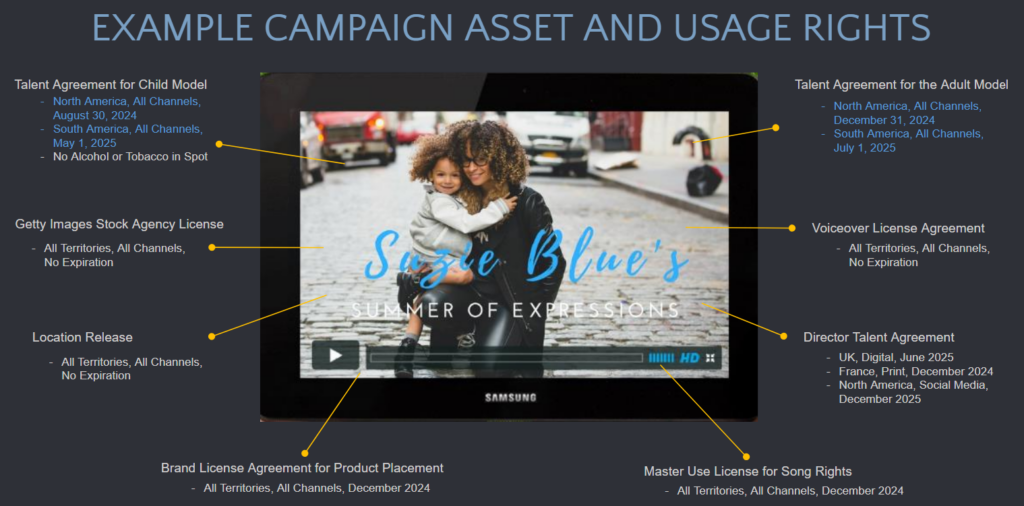6 Benefits of Tracking Image & Video Content Post-Distribution
![]() When most people think about Digital Asset Management (DAM), they tend to focus on the “digital assets” part, e.g., creation, storage, organization, metadata tagging, sharing, and downloading. But what about the “management” part of Digital Asset Management? Managing digital assets is about much more than simply having a place to store them and a way to search, find, and access them—functions that are typically tied to pre-production and production tasks. Managing digital assets means taking control of assets from end-to-end, across the content lifecycle.
When most people think about Digital Asset Management (DAM), they tend to focus on the “digital assets” part, e.g., creation, storage, organization, metadata tagging, sharing, and downloading. But what about the “management” part of Digital Asset Management? Managing digital assets is about much more than simply having a place to store them and a way to search, find, and access them—functions that are typically tied to pre-production and production tasks. Managing digital assets means taking control of assets from end-to-end, across the content lifecycle.
Some of the most impactful events for a brand happen post distribution, when assets are already out in the wild. Most licenses change over time as rights expire, restrictions kick in, or assets are further transformed and re-used. This can lead to inadvertent misuse, which can result in lawsuits that risk tarnishing your brand and costing you sales, customers, and your reputation. Because of this, it’s important to extend management of your digital assets outside of your DAM post distribution. It’s not enough to simply publish and forget. The ability to pinpoint your assets and change them out, take them down, or update them is crucial, which is why content tracking is increasingly becoming a foundational component of an effective content strategy.
This article outlines six drivers for post-distribution content tracking:
- Tracking expiring content
- Tracking violations and misuse
- Tracking spokespersons
- Tracking your brand
- Tracking infringement
- Tracking performance
Let’s take a deeper dive into each of these drivers and how they can support digital brand compliance.
1. Identifying expiring content before it happens
While you may sometimes be able to purchase an asset for universal and perpetual use, in many cases, talent, asset, or content usage contracts have expiration terms that need to be adhered to. With the expanding volume of media channels, it can be difficult to locate and take down expiring content before it is in violation, yet the proliferation of channels is not the only consideration. Expiration dates may also be tied to other usage terms, for example regions, talent rights, third-party ownership, or brand guidelines.
 Let’s use the photograph below as an example of how tracking expirations can get unwieldy. Let’s say the model agreement for the adult grants usage until December 31, 2024 in North America, yet in South America the expiration date is July 1, 2025, so you would have to track usage by territory. To further complicate matters, the child’s model agreement only grants usage through August 30, 2024 in North America, and in South America, it can be used through May 1, 2025. This means that the expiration date depends on where the photograph is published and which model’s agreement expires first. The water can be further muddied by channel usage restrictions, for example different terms across print, web, and social.
Let’s use the photograph below as an example of how tracking expirations can get unwieldy. Let’s say the model agreement for the adult grants usage until December 31, 2024 in North America, yet in South America the expiration date is July 1, 2025, so you would have to track usage by territory. To further complicate matters, the child’s model agreement only grants usage through August 30, 2024 in North America, and in South America, it can be used through May 1, 2025. This means that the expiration date depends on where the photograph is published and which model’s agreement expires first. The water can be further muddied by channel usage restrictions, for example different terms across print, web, and social.
In order to get the greatest value out of your investment, you need to be able to track the image’s individual usage restrictions along with its full expiration date, when it is no longer eligible to be used anywhere. Notifications or reporting can inform responsible parties to unpublish or remove assets that are or are nearing full expiration.
Considering that manually tracking all of these assets after they have been published to various channels is difficult—or, depending on the scope of the campaign, even impossible–using content tracking technology to identify and manage expiring content post-publication is particularly useful in keeping your brand out of hot water.
Content tracking technology powered by AI can be used to scan websites, social media feeds, e-commerce, and partner sites to flag items that are expired or nearing expiration. If that intelligence is then used to automate actions, such as issuing a renewal agreement or sending a takedown notice, it becomes even more powerful.
FADEL’s case study on a multinational’s challenge with post-distribution content tracking serves as a cautionary tale of potential risk and a testament to how technology can come to the rescue.
2. Being the first to know about content violations and misuse
Over the course of the content lifecycle, there are a lot of users accessing your assets. Brand managers, product owners, designers, agencies, and customers are just some of the roles that interact with the content in your DAM, and with each step, there is the possibility of misuse. A solid rights management strategy is essential to stay in compliance as your campaign proceeds through the workflow—but again, traditional management strategies often fall short once the campaign is launched.
In many cases, content is republished by partners and regional brands, for example, and they may not have access to the asset rights. This leaves your brand exposed.
A content tracking system can protect you even when the situation is out of your hands. It gives you the ability to monitor not only your media channels but partner sites as well so you can identify and take down content that is in violation.
3. Keeping tabs on brand ambassadors
 The objective of hiring brand ambassadors is to boost brand recognition and cast your brand in a positive light. Tracking your content that features them is important for both campaign optimization and brand protection. Let’s take two scenarios:
The objective of hiring brand ambassadors is to boost brand recognition and cast your brand in a positive light. Tracking your content that features them is important for both campaign optimization and brand protection. Let’s take two scenarios:
- Big wins can jettison an influencer to mega levels. While this may also increase their price per post, if you already have a relationship, amplifying the use of existing content within the scope of your agreement can promote your brand image and increase sales.
- Conversely, scandals or offensive remarks by a brand ambassador can reflect negatively upon your brand. A prime example is the litany of brands that severed partnerships with Kanye West after his antisemitic comments on social media. These brands had to rapidly remove content featuring Ye, both because of negative associations and because of potential violations after their contracts with the rapper were terminated.
These changes in perception can either help or harm your brand, but the common factor in both scenarios is that timing is everything. Scrambling to manually find content featuring brand ambassadors across brand websites, partner sites, e-retailers, social media feeds, and other digital outlets can not only waste precious time, manual efforts are also much more likely to overlook instances of content usage because there is simply too much ground to cover.
There are multiple, more efficient ways to perform this matching.
- Some technologies embed a hidden watermark or pixel in images in order to identify them. While this can be effective, it relies on the imprint being there and not being changed or manipulated (e.g., cropped out).
- Other tools use sophisticated AI-matching algorithms, which can identify visual matches. This is a more powerful means of finding matches that may have been altered or transformed.
- In addition, capabilities like audio matching or facial recognition can add value, and metadata or tag analysis can also be useful.
With a content tracking and matching system in place, you’ll be able to quickly and effectively react to situations that could pose either an opportunity or a risk.
4. Staying on-brand
There are several circumstances that could pose a challenge to brand consistency:
- Rebranding efforts, including changes to your logo, name, or product packaging, are very common with larger brands and can be difficult to manage. It is necessary to identify all instances of the old brand or logo in order to remove them or swap them out for new assets.
- Outdated campaigns, for example special offers, seasonal promotions, or one-time events that have been marketed across channels, can resurface, making your brand feel stale or giving the impression that you’re not on top of your game.
- Product recalls may require takedowns of online assets from e-commerce or retail sites, including third-party resellers.
While a DAM is quite useful to help maintain brand consistency by storing and curating approved brand assets such as logos and trademarks, it won’t help once those assets are out in the world. Just do a web search for the logo of any large brand and you will likely see all sorts of different versions, old and new. Of course, much of this internet content is posted by third-parties and probably out of your control (for example a Pinterest site dedicated to the design history of a brand). But with a content tracking and matching system that leverages AI for visual similarity searching and/or object matching, you’ll be able to ensure that only the most current, approved logos and brand assets are being utilized on your brand sites, social media feeds, and partner or retailer websites.
5. Detecting third-party copyright infringement
 When a third party copies your content and reuses it in ways that are outside of the license terms, it may not be your responsibility, but it can still reflect poorly upon your brand. There are two prominent instances where this might happen:
When a third party copies your content and reuses it in ways that are outside of the license terms, it may not be your responsibility, but it can still reflect poorly upon your brand. There are two prominent instances where this might happen:
- Unapproved usage. In some cases, third parties may appropriate or use your content in ways it is not licensed for. For example, someone copies an image off your site and publishes it somewhere they shouldn’t. In these cases, it may still be beneficial to know where your content ends up and how it’s being used by others, since even though you may not be liable, you may want to send a cease and desist letter if the content misuse reflects poorly on your brand.
- Counterfeit products. Studies estimate that billions of dollars in revenue are lost each year due to piracy and unauthorized sharing of copyrighted content. Third-party companies who are producing counterfeits may use your real product assets to sell their fakes. In these cases, it becomes valuable to find those assets, since not only can you have them taken down, but it may identify broader copyright infringement actions you can pursue against counterfeiters. If your brand is a candidate for counterfeiting, content tracking can help you search the broader internet for content.
6. Gaining insight into performance
Content and brand tracking aren’t just preventative—they can provide key information about performance and usage trends that will help you develop a more effective channel strategy. When content tracking is integrated with your DAM assets, you gain visibility into where your assets are appearing across distribution channels and which assets were favored by partners. Then, you can cross-reference that data with metrics like shares, likes, reposts, site visits, abandoned carts, and conversions. These asset analytics can be applied to better inform your marketing spend.
In addition, performance analytics can help you decide which types of content you should produce more of, broaden, or repurpose.
Using post-distribution content tracking as a game changer
Brand consistency and reputation are important areas where content tracking can be valuable to help enforce governance and maintain the integrity of your products and campaigns. Whether you’re dealing with a logo change or an urgent need to change talent assets, having the ability to use content tracking to scan your distribution sites and identify any assets that need to be changed or removed can save hundreds of hours of cumbersome work. It can also help identify third-party infringement and counterfeits.
Knowing how well your assets are performing is certainly a boon to any marketer, and using content tracking to consolidate usage information can be a powerful way to provide a single view of where an asset was used. When social media or other metrics are added into the mix, content tracking can provide a valuable basis for an asset analytics platform that can help drive brand marketing decisions.
As the omni-channel universe continues to expand, so do the use cases for content tracking. Companies that adopt a strategy to manage assets post distribution will find themselves ahead of the curve.










